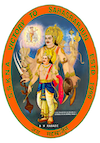The word Sahasra virtually means a thousand. For many it means the dominance of emperor Arjun over the evil. In mythological art, the pictorial expression of the strength of Gods is depicted with multiple hands and brain power with multiple heads. There are other explanations on the expression of strength of Sahasrarjun in the form of fables and mythical tales. It is the subject of this article. The illustrations presented here are designed in the interest of youngsters, who have little or no direct contact with the main core SSK community.
However, for reading the text the parents guidance may be required. Hopefully it will arouse curiosity in them over the glories of our past. Pictorially we have presented ten pairs of hands to represent the thousand hands of Sahasrarjun following the original painting by Shri Kale of Gadag.


















